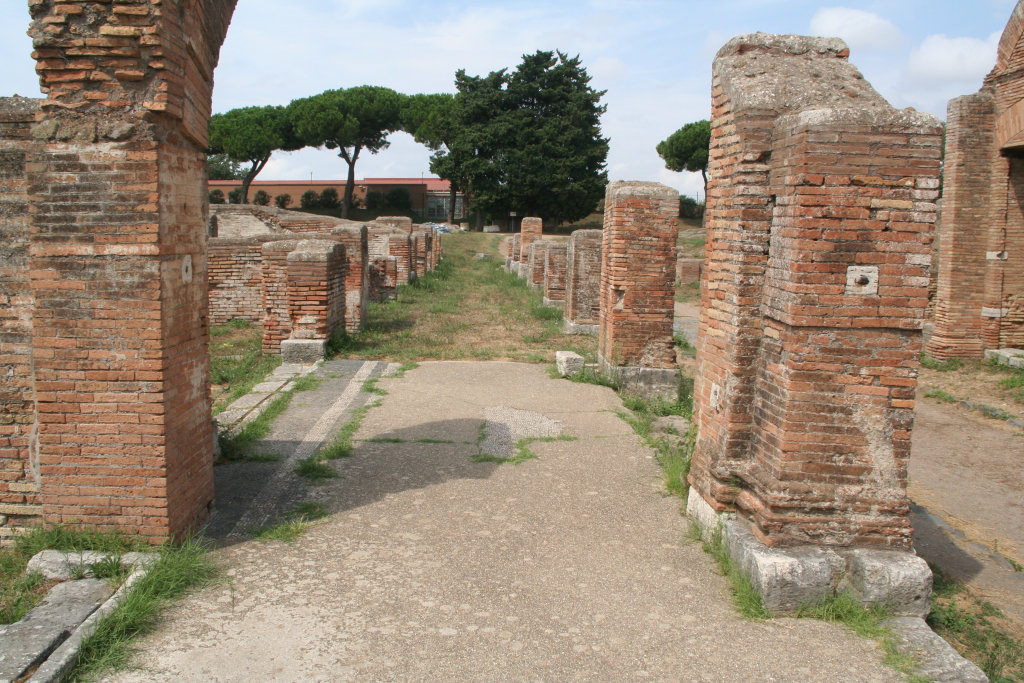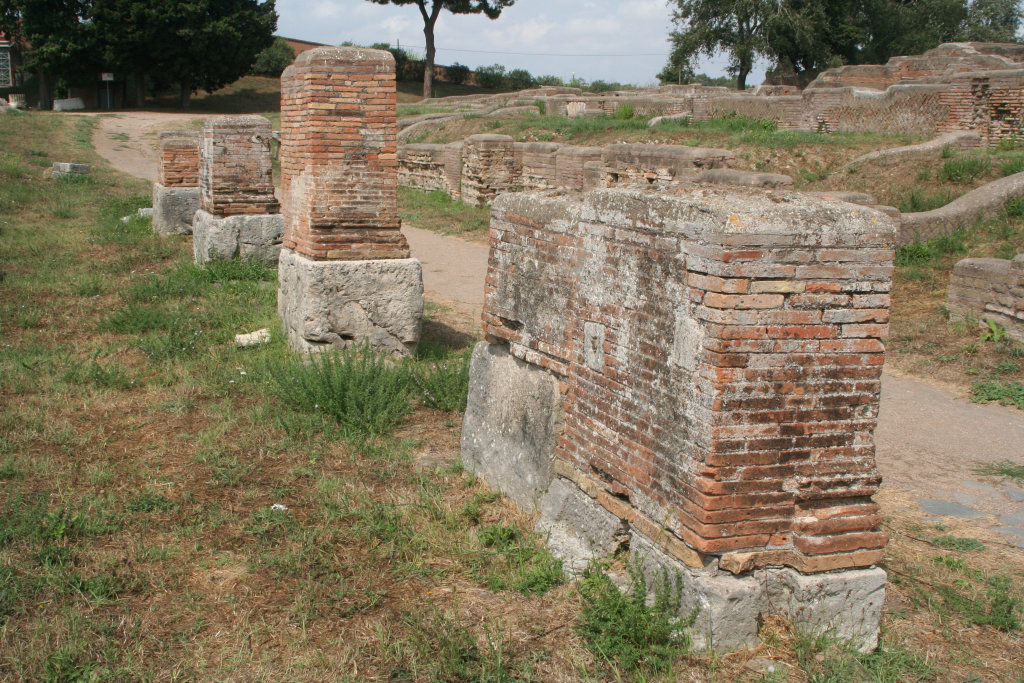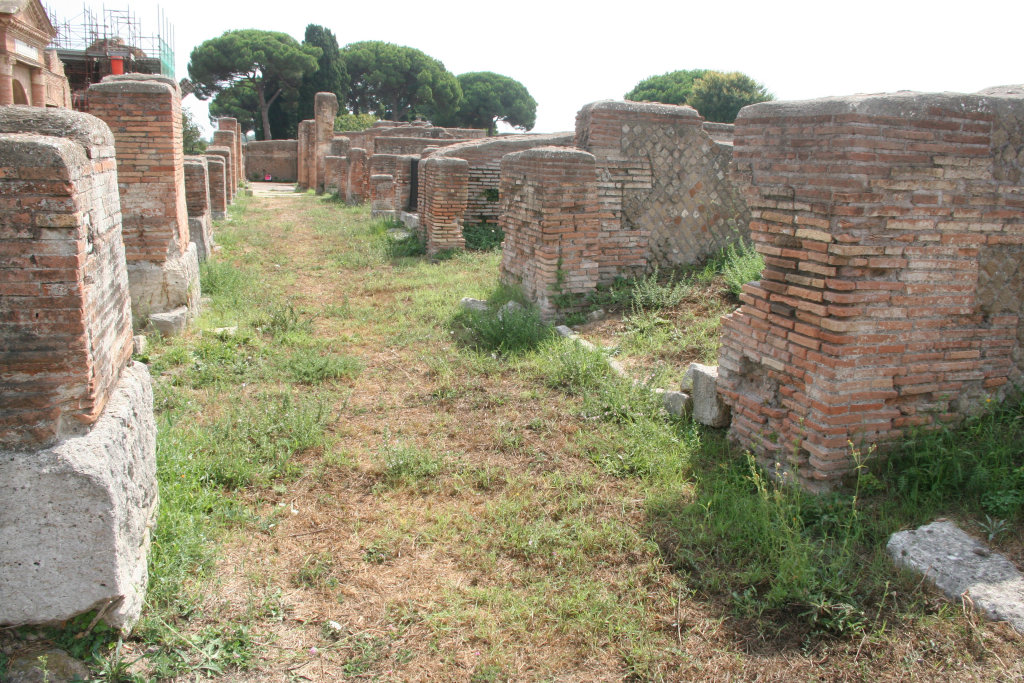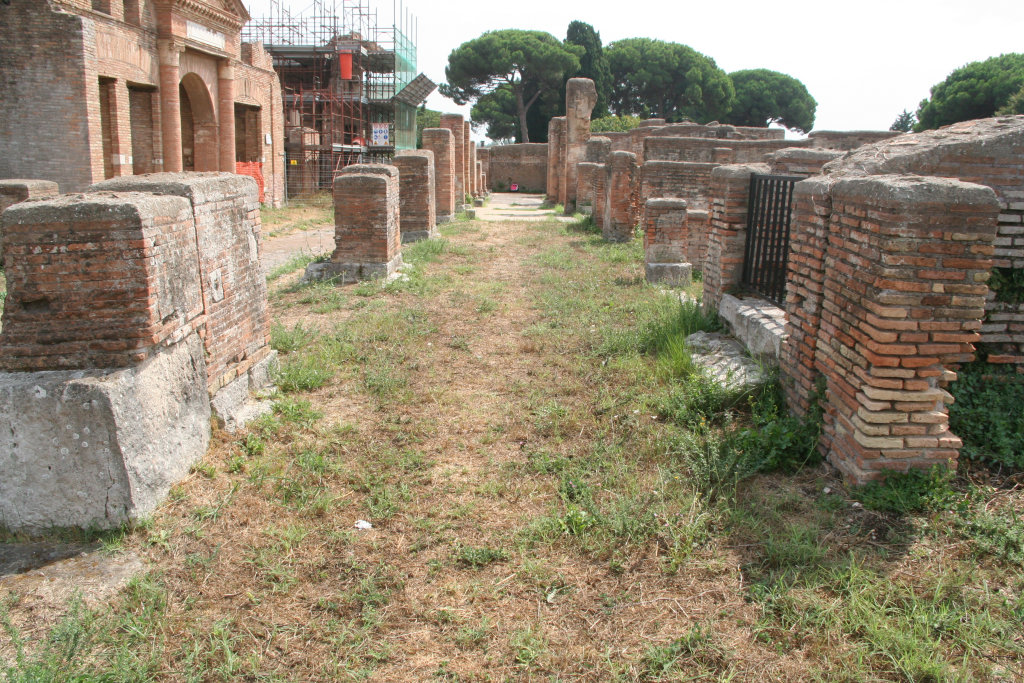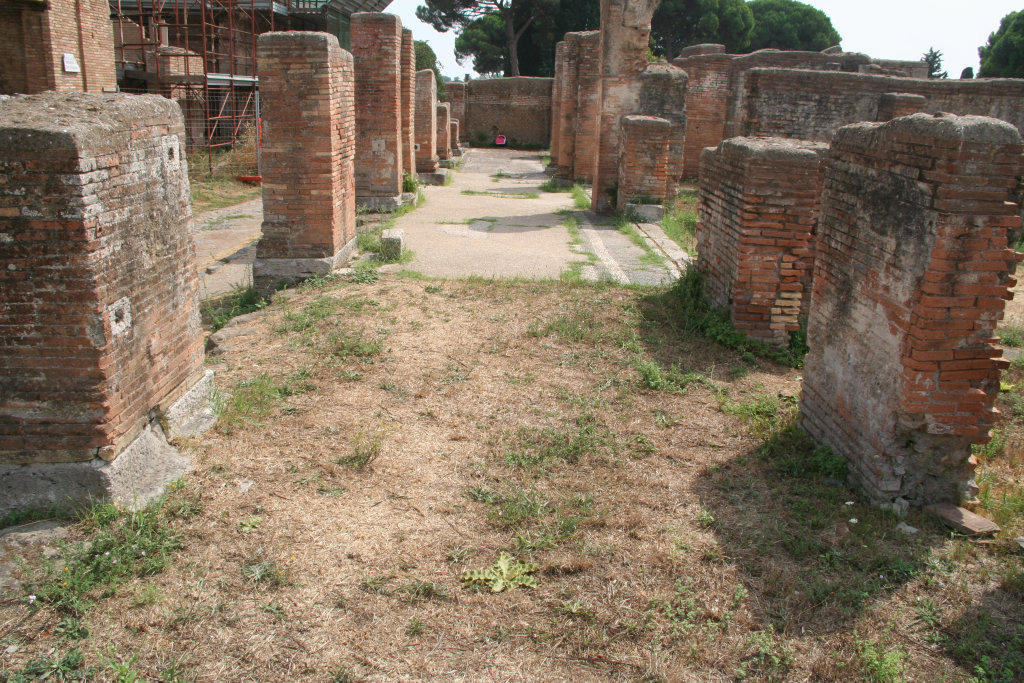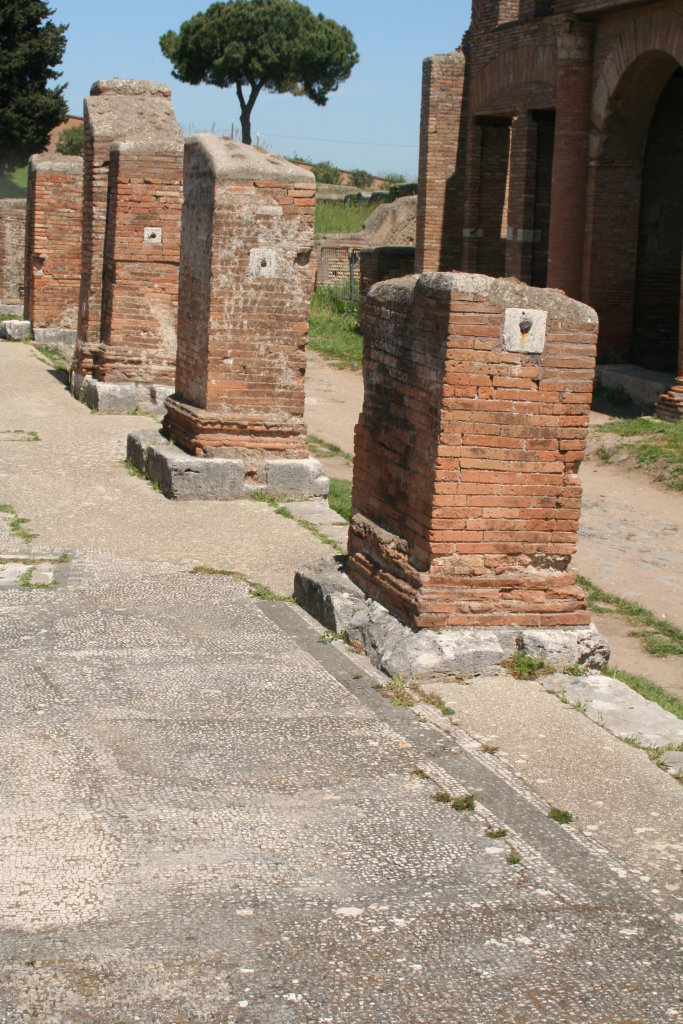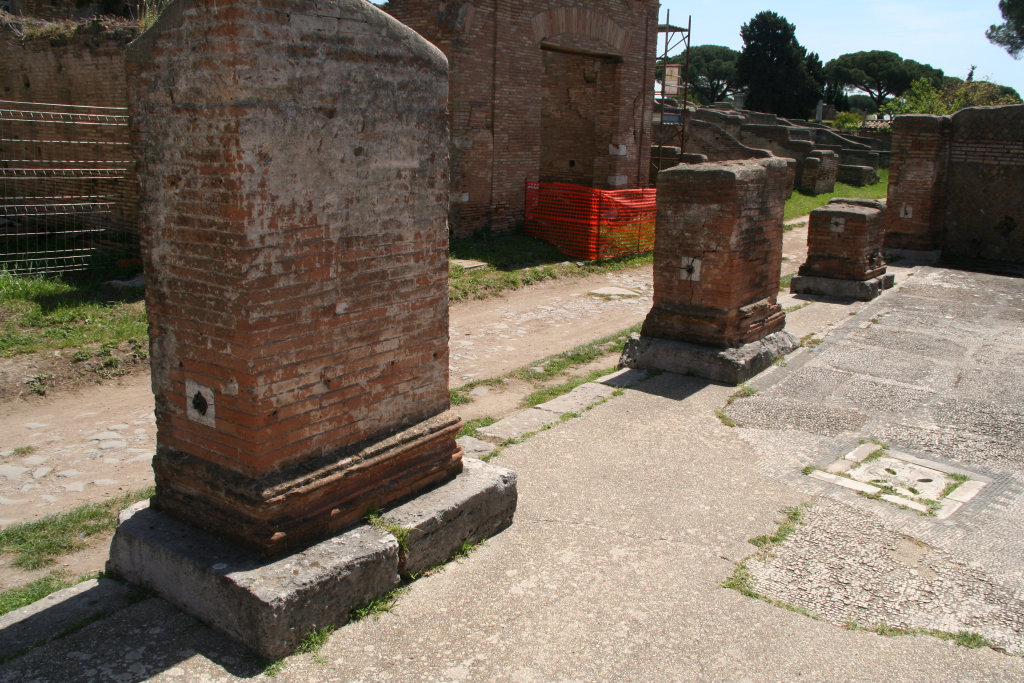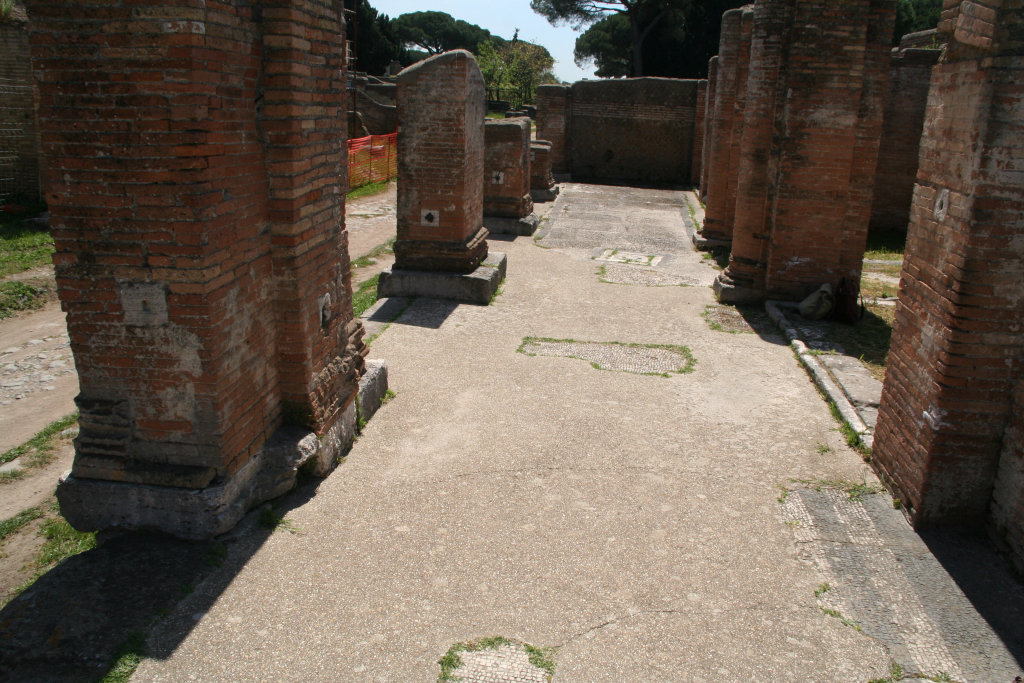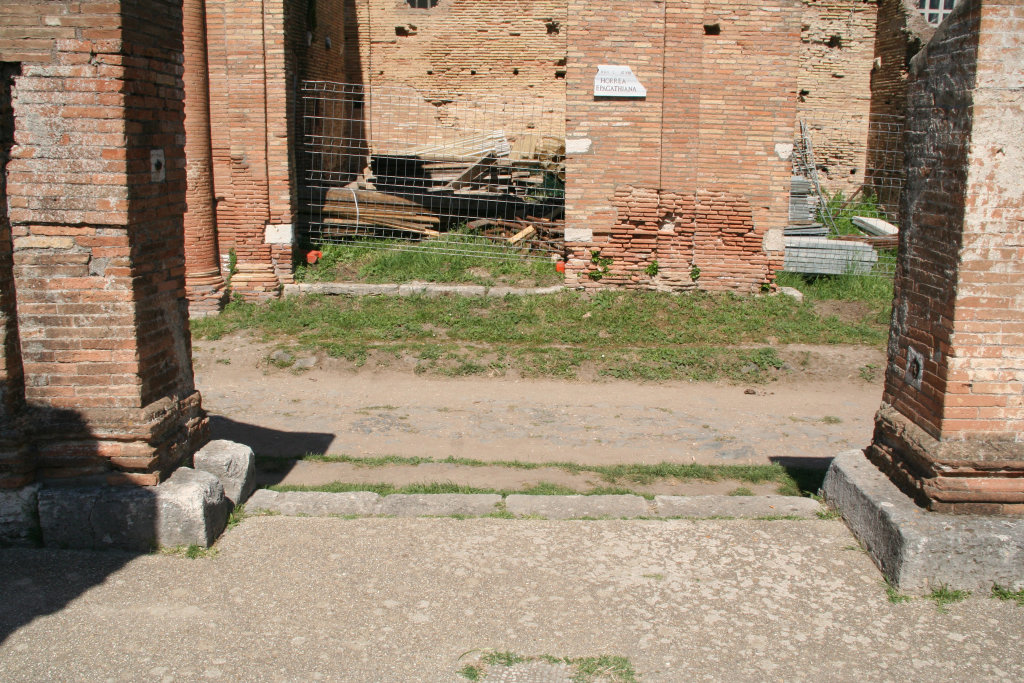|
| The building |
| Description and function |
The Baths of Buticosus are situated to the west of the Via degli Horrea Epagathiana. The bathing rooms are behind a row of shops and a portico to the east. Some of the rooms behind the portico form part of the baths. |
| Date |
Built during the reign of Trajan. |
|
Nrs. 473-488
|
| Description |
Centralized stones are found in the piers of the portico to the east of the building. The portico is in front of 15 rooms and staircases. Further study of these rooms in situ is necessary for a better understanding of their function. The piers of the portico rest on travertine bases and usually have a brick moulding of several layers on top of the base. There are remains of plaster on the piers and on the facade of the rooms. The piers have been numbered I-XIII, from south to north. Pier XIII is lost.
Pier I. In the north side of this corner pier is low stone 473 (on top of the 10th brick layer). In the centre is a hole with metal. Directly above this hole is more metal in a vertical crack in the stone. Furthermore an iron nail or pin is in the mortar to the east of the upper part of the stone, c. 0.15 away. The situation at the base of this pier is complex and can only be understood properly with photographs. Below the stone is a small horizontal, rectangular groove in the top of the travertine base, running from north to south. It is partly inside the pier, and partly in front of it.There is a T-shaped groove in the bricks above, indenting the pier: a vertical groove starts above the horizontal groove in the base; frtom the top a small horizontal groove runs to the east and a wide horizontal groove to the west. The bricks below the horizontal grooves are damaged or indented. Is all this related to some rotating object?
Photos: east and north, north, north, west.
Pier II. There is no stone in the south side (the lower 12 brick layers are ancient). In the centre of the travertine base is a vertical groove. The 2nd brick layer is slightly protruding, but missing above the groove. There is a wide groove in the centre of the brick moulding on the east side, but not in the base. There is a groove in the base on the west side, and in this side may be some metal in the masonry (this must be checked; no proper photograph available). In the north side is low stone 474 (on top of the 11th brick layer). In the centre is a hole with metal.
Photos: south and east, north and east, detail of nr. 474, groove south, south-west corner.
Pier III. In the south side is high stone 475 (on top of the 23rd brick layer). In the centre is a hole with metal. In the centre of the travertine base is a vertical groove. The brick moulding on the east side is damaged (a rough semicircular indentation). In the north side is low stone 476 (on top of the 10th brick layer). In the centre is a hole with metal.
Photos: south and east, detail of nr. 475, north and east, detail of nr. 476, north-west corner.
Pier IV. In the south side is high stone 477 (on top of the 24th brick layer). In the centre is a hole with metal. In the centre of the travertine base is a vertical groove. In the north side is low stone 478 (on top of the 8th brick layer). In the centre is a hole with metal. Furthermore an iron nail or pin is in the mortar slightly above the top left (east) corner of the stone, in the mortar of the second brick layer above the stone.
Photos: south and east, detail of nr. 477, north and east, detail of nr. 478, detail of nr. 478, detail of nr. 478 and of iron nail or pin.
Pier V. Pier V consists of two segments, a northern and a southern one. In fact a pier (north) was set against a corner pier. As a result, the pier is T-shaped, with a protruding west side. The top of the travertine base below the north segment is somewhat higher than that of the southern base. In the south side is high stone 479 (on top the 25th brick layer). In the centre is a hole with metal. A curved hook has been preserved, pushed to one side. In the centre of the travertine base is a vertical groove. In the north side is low stone 480 (on top of the 14th brick layer, clearly higher than the low stones described so far). In the centre is a square hole (0.04 x 0.03). A brick moulding was made to the east of stone 480 only. Below the stone and to the west the pier is flat. In the west side of the protruding part is low stone 481 (on top of the 10th brick layer). in the lower part is a large hole with metal. Cf. stone 488.
Photos: south and east, north and east, north and east, south and east, south and east, detail of hook in nr. 479, detail of hook in nr. 479, south and west, south and west, detail of nr. 481, south and west.
Pier VI. There is no stone in the south side, that seems to have 37 ancient brick layers. The lower part mirrors pier V, north, with a moulding on the east side only. There is no stone in the north side, that seems to have 39 ancient brick layers. Again only the east side has a brick moulding.
Photos: south and east, north and east, moulding north.
Pier VII. There is no stone in the south side, that seems to have 26 ancient brick layers. Only the east part has a brick moulding. There is no stone in the north side, that seems to have some 25 ancient brick layers. The entire north side has a brick moulding. In the west side are two stones. At the north end is low stone 482 (on top of the 10th brick layer). In the centre is a rectangular hole with metal. At the south end is high stone 483 (on top of the 23rd brick layer). In the centre is a square hole with metal.
Photos: south and east, north and east, west and south, west and south, detail of nr. 483, detail of nr. 482, north and west, the east side of the north jamb of the entrance of room 6, opposite nrs. 482-483, west and south, west and south, north and west.
Pier VIII. There is no stone in the south side, that seems to have 19 ancient brick layers. The entire south side has a brick moulding. There is no stone in the north side, that seems to have some 17 ancient brick layers. There is no brick moulding on the north side.
Photos: south and east, north and east.
Pier IX. This pier consists of two segments, a northern and a southern one. The northern one rest on a much higher travertine base than the southern one. There is no stone in the south side. There is however a vertical groove in the west part of the travertine base. Only the east part, to the right of this groove, has a brick moulding. In the east side, at the north end of the southern section, is a vertical groove, both in the travertine base and in the bricks above. There is an iron nail or pin above this groove, in the mortar between the 17th and 18th brick layer. There is no stone in the north side, which seems to have 13 ancient brick layers, on top of the very high travertine base. There is a brick moulding on the entire north side. In the west side of the southern section are two stones. At the north end is low stone 484 (on top of the 10th brick layer). In the centre is a hole with metal. At the south end is low stone 485, only a bit higher than nr. 484 (on top of the 13th brick layer). It has a flat surface, there is no hole.
Photos: south and east, east, east, detail of groove, north, west, detail of nr. 484, west, the facade of staircase 9, opposite nrs. 484-485, looking east from the north end of the threshold of startcase 9, west and south.
Pier X. The pier rests on a very high travertine base. There is no stone in the south side, that seems to have 15 ancient brick layers. The entire south side has a brick moulding. There is no stone in the north side, that seems to have some 25 ancient brick layers. The entire north side has a brick moulding.
Photos: south and east, north and east.
Pier XI. The pier rests on a very high travertine base. In the south side is high stone 486 (on top of the 17th brick layer). In the upper part is a hole with metal. A hook a straight angles has been preserved, the horizontal part 0.08 long and flat, the vertical part 0.07 high and square. There is no groove in the base and the entire south side has a brick moulding. There is no stone in the north side, that seems to have 19 ancient brick layers. The entire north side has a brick moulding. At the north end of the west side is stone 487 (on top of the 12th brick layer). In the centre is a hole with metal.
Photos: south and east, detail of nr. 486, north, south and west, detail of nr. 487, north and west, the east side of the north jamb of room 11, opposite stone 487, detail of nr. 486, detail of nr. 486, west and south.
Pier XII. Only a few brick layers and no stones have been preserved. There seems to be a vertical groove in the upper part of the moulding on the north side.
Photos: south and east, north, moulding north.
Room 4. In the east side of the north jamb of the entrance of room 4 is high stone 488. It is opposite stone 481 in pier V, west.
Photos: east, east, detail of nr. 488.
|
| Date |
The stones seem to belong to the first building phase. |
| Measurements |
Meas. according to VdM: low stones in piers I-V start at 0.40-0.60; high stones in piers I-V start at 1.00-1.15. Av. l. 0.15, av. h. 0.15. Av. diam. of holes with metal 0.04-0.05. Grooves in travertine bases typically 0.14 high, 0.15 wide and 0.20 deep. |
| Remarks |
Note that in the southern piers the blocks at the north side are low, those in the south side higher. Only below the higher stones are vertical grooves in the travertine bases.
In many cases the metal in the stones consists of the remains on an iron object that was fastened with a lead plug. In nrs. 479 and 486 an entire hook has been preserved. It could be that ropes were suspended from the hooks. When the ropes were not used, they could be hanging down in the grooves.
|
|
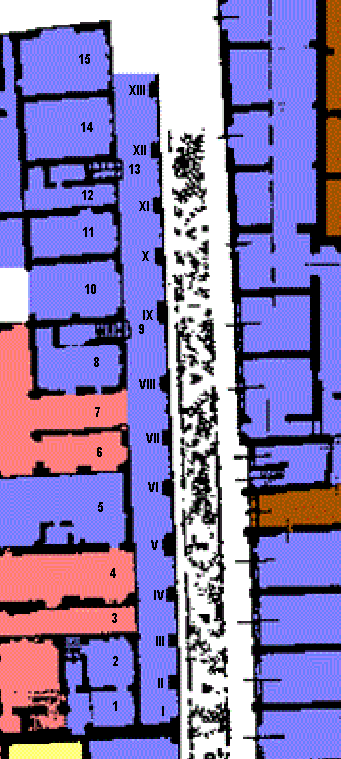
Plan of the east part of the building. After SO I.
|

